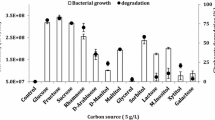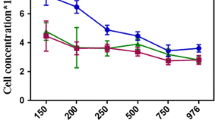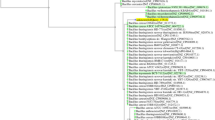Abstract
Malathion, a pesticide used to control pests in crops, vegetables, fruits, and livestock. Its widespread and indiscriminate usage has ensued in different ecological issues, thus, it’s vital to remediate this insecticide. Malathion degrading bacterium Bacillus sp. AGM5, isolated from pesticide contaminated agricultural field was cultured in presence of different malathion concentrations under aerobic and energy restrictive conditions and was found effective at malathion degradation. Recovered malathion was extracted based on QuEChERS approach and then analyzed by UHPLC. About 39.5% of malathion biodegradation was observed at 300 µlL−1 after 96 h of incubation with the tested bacteria which increased to 58.5% and 72.5% after 240, and 360 h of incubation, respectively. To further enhance malathion biodegradation, the effects of co-substrates, pH, temperature, initial malathion concentration, agitation (rpm), and inoculum size were evaluated using Taguchi methodology. Taguchi DOE’s ability to predict the optimal response was established experimentally via optimised levels of these factors (glucose-0.1%, yeast extract-0.1%, inoculum size-2% wv−1, malathion concentration 300 µlL−1, rpm-150, pH-7, temperature 40 °C), whereby biodegradation rate was enhanced to 95.49% after 38 h. Confirmation of malathion biodegradation was performed by UHPLC, Q-TOF–MS, GC–MS analysis and a possible degradation pathway was proposed for malathion biodegradation. First order kinetic model was appropriate to describe malathion biodegradation. The Taguchi DOE proved to be viable tool for optimizing culture conditions and analysing the interactions between process parameters in order to attain the best feasible combination for maximum malathion degradation. These results could influence the development of a bioremediation strategy.
Graphical abstract







Similar content being viewed by others
References
Abdelbagi AO, Wady AIA, Hammad AMA, Abdalla MAO, Hur JH (2018) Biodegradation of fenthion and temphos in liquid media by Bacillus safensis isolated from pesticides polluted soil in the Sudan. Afr J Biotechnol 17(12):396–404
Abo-Amer A (2007) Involvement of chromosomally encoded genes in malathion utilization by Pseudomonas aeruginosa AA112. Acta Microbiol Immunol Hung 54(3):261–277
Adhikari S, Chattopadhyay P, Ray L (2010) Biosorption of Malathion by immobilized cells of Bacillus sp. S14. Chem Speciat Bioavailab 22(4):271–276
Alfonso LF, Germán GV, Del Carmen PCM, Hossein G (2017) Adsorption of organophosphorus pesticides in tropical soils: the case of karst landscape of northwestern Yucatan. Chemosphere 166:292–299
Altschul SF, Gish W, Miller W, Myers EW, Lipman DG (1990) Basic local alignment search tool. J Mol Biol 215:403–410
Anand TJS (2010) DOE based statistical approaches in modeling of laser processing-review & suggestion. Int J Eng Technol IJET-IJENS 10(4):1–7
Anwar S, Liaquat F, Khan QM, Khalid ZM, Iqbal S (2009) Biodegradation of chlorpyrifos and its hydrolysis product 3, 5, 6-trichloro-2-pyridinol by Bacillus pumilus strain C2A1. J Hazard Mater 168(1):400–405
Asghar A, Abdul Raman AA, Daud WMAW (2014) A comparison of central composite design and Taguchi method for optimizing Fenton process. Sci World. https://doi.org/10.1155/2014/869120
Azmy AF, Saafan AE, Essam TM, Amin MA, Ahmed SH (2015) Biodegradation of malathion by Acinetobacter baumannii strain AFA isolated from domestic sewage in Egypt. Int J Bioeng Life Sci 9(1):55–65
Beg QK, Sahai V, Gupta R (2003) Statistical media optimization and alkaline protease production from Bacillus mojavensis in a bioreactor. Process Biochem 39(2):203–209
Boix C, Ibáñez M, Sancho JV, Parsons JR, de Voogt P, Hernández F (2016) Biotransformation of pharmaceuticals in surface water and during wastewater treatment: identification and occurrence of transformation products. J Hazard Mater 302:175–187
Bouzid I, Maire J, Brunol E, Caradec S, Fatin-Rouge N (2017) Compatibility of surfactants with activated persulfate for the selective oxidation of PAH in groundwater remediation. J Environ Chem Eng 5(6):6098–6106
Buchanan RE, Gibbons NE (1974) Bergey’s manual of determinative bacteriology. The Williams and Wilkins Co. 208, Baltimore
Budischak SA, Belden LK, Hopkins WA (2009) Relative toxicity of malathion to trematode-infected and noninfected Rana palustris tadpoles. Arch Environ Contam Toxicol 56(1):123–128
Chenthamarakshan A, Parambayil N, Miziriya N, Soumya PS, Lakshmi MK, Ramgopal A, Nambisan P (2017) Optimization of laccase production from Marasmiellus palmivorus LA1 by Taguchi method of design of experiments. BMC Biotechnol 17(1):1–10
Cisse MB, Keita C, Dicko A, Dengela D, Coleman J, Lucas B, Beach R (2015) Characterizing the insecticide resistance of Anopheles gambiae in Mali. Malar J 14(1):1–10
Daneshvar N, Khataee AR, Rasoulifard MH, Pourhassan M (2007) Biodegradation of dye solution containing Malachite Green: optimization of effective parameters using Taguchi method. J Hazard Mater 143(1–2):214–219
Dar MA, Kaushik G, Villarreal-Chiu JF (2019) Pollution status and bioremediation of chlorpyrifos in environmental matrices by the application of bacterial communities: a review. J Environ Manag 239:124–136
Dar MA, Kaushik G, Chiu JFV (2020) Pollution status and biodegradation of organophosphate pesticides in the environment. Abatement of environmental pollutants. Elsevier, Amsterdam, pp 25–66
Dar MA, Baba ZA, Kaushik G (2022) A review on phorate persistence, toxicity, and remediation by bacterial communities. Pedosphere 32(1):171–183
Das A, Singh J, Yogalakshmi KN (2017) Laccase immobilized magnetic iron nanoparticles: fabrication and its performance evaluation in chlorpyrifos degradation. Int Biodeterior Biodegr 117:183–189
Delmore JE, Appelhans AD (1991) Detection of agricultural chemical residues on plant leaf surfaces with secondary ion mass spectrometry. Biol Mass Spectrom 20(5):237–246
Geed SR, Kureel MK, Shukla AK, Singh RS, Rai BN (2016) Biodegradation of malathion and evaluation of kinetic parameters using three bacterial species. Res Effic Technol 2:S3–S11
Ghani JA, Choudhury IA, Hassan HH (2004) Application of Taguchi method in the optimization of end milling parameters. J Mater Process Technol 145(1):84–92
Ghormade V, Deshpande MV, Paknikar KM (2011) Perspectives for nano-biotechnology enabled protection and nutrition of plants. Biotechnol Adv 29(6):792–803
Gianfreda L, Rao MA (2004) Potential of extra cellular enzymes in remediation of polluted soils: a review. Enzyme Microb Technol 35(4):339–354
Goda SK, Elsayed IE, Khodair TA, El-Sayed W, Mohamed ME (2010) Screening for and isolation and identification of malathion-degrading bacteria: cloning and sequencing a gene that potentially encodes the malathion-degrading enzyme, carboxylestrase in soil bacteria. Biodegrad 21(6):903–913
Gurushankara HP, Krishnamurthy SV, Vasudev V (2007) Effect of malathion on survival, growth, and food consumption of Indian cricket frog (Limnonectus limnocharis) tadpoles. Arch Environ Contam Toxicol 52(2):251–256
He F (2011) E. Coli genomic DNA extraction. Bio-protocol. University of Pennsylvania, Department of biology, Philadelphia, USA
Horiike T (2016) An introduction to molecular phylogenetic analysis. Rev Agric Sci 4:36–45
Hussain S, Shahzad T, Imran M, Khalid A, Arshad M (2017) Bioremediation of isoproturon herbicide in agricultural soils. Microbe-induced degradation of pesticides. Springer, Cham, pp 83–104
IARC (International Agency for Research on Cancer) (2015). Evaluation of five organophosphate insecticides and herbicides (WHO), 20 March. Monographs 112.
Janeczko AK, Walters EB, Schuldt SJ, Magnuson ML, Willison SA, Brown LM, Racz L (2014) Fate of malathion and a phosphonic acid in activated sludge with varying solids retention times. Water RES 57:127–139
Kang ZH, Dong JG, Zhang JL (2012) Optimization and characterization of nicosulfuron-degrading enzyme from Bacillus subtilis strain YB1. J Integr Agric 11(9):1485–1492
Kashyap PL, Xiang X, Heiden P (2015) Chitosan nanoparticle-based delivery systems for sustainable agriculture. Int J Biol Macromol 77:36–51
Kaushik G, Thakur IS (2009) Isolation of fungi and optimization of process parameters for decolorization of distillery mill effluent. World J Microbiol Biotechnol 25(6):955–964
Khan S, Zaffar H, Irshad U, Ahmad R, Khan AR, Shah MM, Naqvi T (2016) Biodegradation of malathion by Bacillus licheniformis strain ML-1. Arch Biol Sci 68(1):51–59
Khayati G, Barati M (2017) Bioremediation of petroleum hydrocarbon contaminated soil: optimization strategy using Taguchi design of experimental (DOE) methodology. Environ Process 4(2):451–461
Kim YH, Ahn JY, Moon SH, Lee J (2005) Biodegradation and detoxification of organophosphate insecticide, malathion by Fusarium oxysporum f. sp. pisi cutinase. Chemosphere 60(10):1349–1355
Kulkarni M, Chaudhari A (2006) Biodegradation of p-nitrophenol by P. putida. Bioresour Technol 97(8):982–988
Kumar R, Nagpure NS, Kushwaha B, Srivastava SK, Lakra WS (2010) Investigation of the genotoxicity of malathion to freshwater teleost fish Channa punctatus (Bloch) using the micronucleus test and comet assay. Arch Environ Contam Toxicol 58(1):123–130
Kumar A, Bhunia B, Dasgupta D, Mandal T, Dey A, Datta S, Bhattacharya P (2013) Optimization of culture condition for growth and phenol degradation by Alcaligenes faecalis JF339228 using Taguchi methodology. Desal Water Treat 51(16–18):3153–3163
Kumar SS, Ghosh P, Malyan SK, Sharma J, Kumar V (2019) A comprehensive review on enzymatic degradation of the organophosphate pesticide malathion in the environment. J Environ Sci Health Part C 37(4):288–329
Li R, Wang J, Li S, Li R, Wang J, Li S (2020) Biodegradation of omethoate by Bacillus sp YB-10: optimization of culture conditions and degradation characteristics. Environ Eng Res 26(4):200235
Madhuri R, Rangaswamy V (2009) Biodegradation of selected insecticides by Bacillus and Pseudomonas sps in ground nut fields. Toxicol Inter 16(2):127
Malghani S, Chatterjee N, Hu X, Zejiao L (2009) Isolation and characterization of a profenofos degrading bacterium. J Environ Sci 21(11):1591–1597
Maya K, Singh RS, Upadhyay SN, Dubey SK (2011) Kinetic analysis reveals bacterial efficacy for biodegradation of chlorpyrifos and its hydrolyzing metabolite TCP. Process Biochem 46(11):2130–2136
Mohamed ZK, Ahmed MA, Fetyan NA, Elnagdy SM (2010) Isolation and molecular characterisation of malathion-degrading bacterial strains from wastewater in Egypt. J Adv Res 1(2):145–149
Mohan SV, Sirisha K, Rao RS, Sarma PN (2007) Bioslurry phase remediation of chlorpyrifos contaminated soil: process evaluation and optimization by Taguchi design of experimental (DOE) methodology. Ecotoxicol Environ Saf 68(2):252–262
Mohan SV, Reddy BP, Sarma PN (2009) Ex situ slurry phase bioremediation of chrysene contaminated soil with the function of metabolic function: process evaluation by data enveloping analysis (DEA) and Taguchi design of experimental methodology (DOE). Bioresour Technol 100(1):164–172
Mostafa IY, Bahig MRE, Fakhr IMI, Adam Y (1972) Metabolism of organophosphorus insecticides, XIV malathion breakdown by soil fungi. Zeitschrift Für Naturforschung B 27(9):1115–1116
Nadalian B, ShahriariMoghadam M, Ebrahimipour G (2016) Biodegradation of malathion by serratia marcescens isolated from Arvandkenar region. Iran Adv Environ Technol 2(1):55–61
Nair AM, Rebello S, Rishad KS, Asok AK, Jisha MS (2015) Biosurfactant facilitated biodegradation of quinalphos at high concentrations by Pseudomonas aeruginosa Q10. Soil Sediment Contam Int J 24(5):542–553
Padmanaban VC, Geed SR, Achary A, Singh RS (2016) Kinetic studies on degradation of reactive red 120 dye in immobilized packed bed reactor by Bacillus cohnii RAPT1. Bioresour Technol 213:39–43
Pant A, Rai JPN (2018) Bioremediation of chlorpyrifos contaminated soil by two phase bioslurry reactor: processes evaluation and optimization by Taguchi’s design of experimental (DOE) methodology. Ecotoxicol Environ Saf 150:305–311
Peng W, Lam SS, Sonne C (2020) Support Austria’s glyphosate ban. Science 367(6475):257–258
Peshin R, Bandral RS, Zhang W, Wilson L, Dhawan AK (2009) Integrated pest management: a global overview of history, programs, and adoption. Integrated pest management: innovation-development process. Springer, Dordrecht, pp 1–49
Qiu X, Zhong Q, Li M, Bai W, Li B (2007) Biodegradation of p-nitrophenol by methyl parathion-degrading Ochrobactrum sp. B2. Int Biodeterior Biodegrad 59(4):297–301
Reddy GS, Reddy BR, Tlou MG (2014) Biodegradation of 2-hydroxyquinoxaline (2-HQ) by Bacillus sp. J Hazard Mater 278:100–107
Rehman A, Raza ZA, Afzal M, Khalid ZM (2007) Kinetics of p-nitrophenol degradation by Pseudomonas pseudomallei wild and mutant strains. J Environ Sci Health A 42(8):1147–1154
Rizzetti TM, Kemmerich M, Martins ML, Prestes OD, Adaime MB, Zanella R (2016) Optimization of a QuEChERS based method by means of central composite design for pesticide multiresidue determination in orange juice by UHPLC–MS/MS. Food Chem 196:25–33
Roy RK (2007) Qualitek-4, software for automatic design and analysis of Taguchi experiments, Nutek, Inc. Bloomfield Hills, Michigan, USA. Free DEMO from. http://nutek-us.com/wp-q4w.html. Accessed 15 Oct 2021
Salunkhe VP, Sawant IS, Banerjee K, Rajguru YR, Wadkar PN, Oulkar DP, Sawant SD (2013) Biodegradation of profenofos by Bacillus subtilis isolated from grapevines (Vitis vinifera). J Agric Food Chem 61(30):7195–7202
Sarkar P, Dey A (2020) 4-Nitrophenol biodegradation by an isolated and characterized microbial consortium and statistical optimization of physicochemical parameters by Taguchi methodology. J Environ Chem Eng 8(5):104347
ShahriariMoghadam M, Ebrahimipour G, Abtahi B, Khazaei N, Karbasi N (2014) Statistical optimization of crude oil biodegradation by Marinobacter sp. isolated from Qeshm Island, Iran. Iran J Biotechnol 12(1):35–41
Shan XIE, Junxin LIU, Lin LI, Chuanling QIAO (2009) Biodegradation of malathion by Acinetobacter johnsonii MA19 and optimization of cometabolism substrates. J Environ Sci 21(1):76–82
Sharma K, Kaushik G, Thotakura N, Raza K, Sharma N, Nimesh S (2019) Fate of ibuprofen under optimized batch biodegradation experiments using Micrococcus yunnanensis isolated from pharmaceutical sludge. Int J Environ Sci Technol 16(12):8315–8328
Sharma K, Kaushik G, Thotakura N, Raza K, Sharma N, Nimesh S (2020) Enhancement effects of process optimization technique while elucidating the degradation pathways of drugs present in pharmaceutical industry wastewater using Micrococcus yunnanensis. Chemosphere 238:124689
Shukla AK, Singh RS, Upadhyay SN, Dubey SK (2011) Substrate inhibition during bio-filtration of TCE using diazotrophic bacterial community. Bioresour Technol 102(3):3561–3563
Singh BK, Walker A, Morgan JAW, Wright DJ (2003) Role of soil pH in the development of enhanced biodegradation of fenamiphos. Appl Environ Microbiol 69(12):7035–7043
Singh R, Paul D, Jain RK (2006) Biofilms: implications in bioremediation. Trends Microbiol 14(9):389–397
Singh B, Kaur J, Singh K (2012a) Biodegradation of malathion by Brevibacillus sp. strain KB2 and Bacillus cereus strain PU. World J Microbiol Biotechnol 28(3):1133–1141
Singh B, Kaur J, Singh K (2012b) Transformation of malathion by Lysinibacillus sp. isolated from soil. Biotechnol Lett 34(5):863–867
Singh B, Kaur J, Singh K (2014) Microbial degradation of an organophosphate pesticide, malathion. Crit Rev Microbiol 40(2):146–154
Sirajuddin S, Khan MA, Qader SAU, Iqbal S, Sattar H, Ansari A (2020) A comparative study on degradation of complex malathion organophosphate using of Escherichia coli IES-02 and a novel carboxylesterase. Int J Biol Macromol 145:445–455
Tamura K, Peterson D, Peterson N, Stecher G, Nei M, Kumar S (2011) MEGA5: molecular evolutionary genetics analysis using maximum likelihood, evolutionary distance, and maximum parsimony methods. Mol Biol Evol 28(10):2731–2739
Tang M, You M (2012) Isolation, identification, and characterization of a novel triazophos-degrading Bacillus sp. (TAP-1). Microbiol Res 167(5):299–305
Tazdait D, Abdi N, Lounici H, Grib H, Mameri N, Pauss A (2013) Biodegradation of malathion with indigenous acclimated activated sludge in batch mode and in continuous-flow packed-bed reactor. Bioremed J 17(4):294–304
Uygun U, Özkara R, Özbey A, Koksel H (2007) Residue levels of malathion and fenitrothion and their metabolites in postharvest treated barley during storage and malting. Food Chem 100(3):1165–1169
Wahla AQ, Iqbal S, Anwar S, Firdous S, Mueller JA (2019) Optimizing the metribuzin degrading potential of a novel bacterial consortium based on Taguchi design of experiment. J Hazard Mater 366:1–9
Zeinat Kamal M, Nashwa AH, Mohamed AI, Sherif EN (2008) Biodegradation and detoxification of malathion by of Bacillus thuringiensis MOS-5. Aust J Basic Appl Sci 2(3):724–732
Zhang H, Zhang Y, Hou Z, Wu X, Gao H, Sun F, Pan H (2014) Biodegradation of triazine herbicide metribuzin by the strain Bacillus sp. N1. J Environ Sci Health B 49(2):79–86
Zheng T, Chen K, Chen W, Wu B, Sheng Y, Xiao Y (2019) Preparation and characterisation of polylactic acid modified polyurethane microcapsules for controlled release of chlorpyrifos. J Microencapsul 36(1):62–71
Zhu SN, Liu DQ, Fan L, Ni JR (2008) Degradation of quinoline by Rhodococcus sp. QL2 isolated from activated sludge. J Hazard Mater 160(2–3):289–294
Acknowledgements
The Department of Science and Technology, New Delhi, India, funded this study by awarding a fellowship to the author under the "Innovation in Science Pursuit for Inspired Research (INSPIRE) [IF170501] scheme (Mohd Ashraf Dar). MNIT, Jaipur is acknowledged for facility and guidance in analysis.
Author information
Authors and Affiliations
Corresponding author
Ethics declarations
Conflict of interest
There are no conflicts of interest declared by the authors.
Ethical approval
All authors carefully read and approved the study.
Consent to participate
All authors carefully read and approved the study.
Consent to publish
All authors red and approved the final version of the manuscript for publication.
Reasearch involving human and animal participants
Human Participants and/or Animals were not involved in this research.
Additional information
Publisher's Note
Springer Nature remains neutral with regard to jurisdictional claims in published maps and institutional affiliations.
Supplementary Information
Below is the link to the electronic supplementary material.
Rights and permissions
About this article
Cite this article
Dar, M.A., Kaushik, G. Optimizing the malathion degrading potential of a newly isolated Bacillus sp. AGM5 based on Taguchi design of experiment and elucidation of degradation pathway. Biodegradation 33, 419–439 (2022). https://doi.org/10.1007/s10532-022-09986-x
Received:
Accepted:
Published:
Issue Date:
DOI: https://doi.org/10.1007/s10532-022-09986-x




